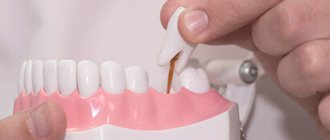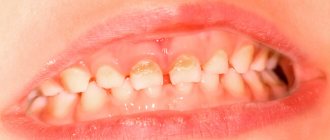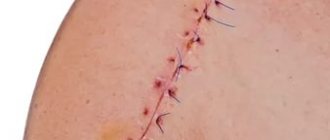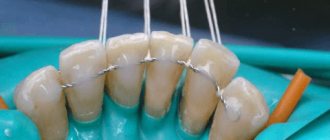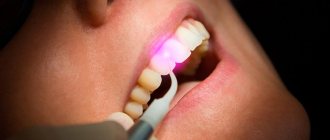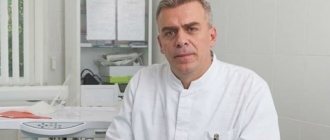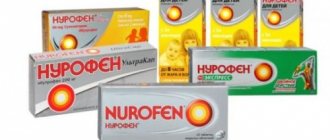Enamel is the hardest tissue in the human body: in some areas the maximum thickness reaches 2 mm. However, due to constant influences (external, internal, sometimes external and internal at the same time), its protective properties decrease, sometimes disappear. And then they talk about tooth decay.
Doctors will be able to answer the question of why an adult’s teeth began to crumble. A comprehensive examination and tests will help to establish the true cause of weakened immunity: a general blood test, biochemistry, hormones, allergen tests, etc.
But you should start with a visit to a competent dentist.
Causes of dental problems in young mothers
To understand why teeth hurt, decay or fall out after childbirth, you first need to understand the processes occurring in the female body during pregnancy and lactation. Let's consider the reasons that provoke weakening of the dental system:
- hormonal changes: lead to a decrease in bone density, at the same time, less nutrients are delivered through the blood to tooth enamel and gums. Therefore, they become more fragile and provide less protection against microbial attack and tooth decay/weakening gums during pregnancy and after childbirth,
- changes in the composition of saliva: it also contains less calcium, phosphorus and fluoride than usual - i.e. again the enamel receives less nutrients,
- lack of minerals and vitamins: primarily due to the fact that they “go” into breast milk, which is necessary for the baby. But it could also be that after giving birth, a woman simply does not know what food she should eat so that there are enough “benefits” for both the baby’s milk and her own health. The roots of the problem may also lie in poor nutrition during pregnancy, when the woman suffered from nausea due to so-called toxicosis,
- deterioration of oral hygiene: not always a young mother can find time to comb her hair or drink tea, not to mention high-quality brushing of her teeth. Meanwhile, a bacterial film and soft plaque forms on them, which subsequently transforms into hard deposits (inhabited by harmful bacteria) - and not a single toothbrush can handle it,
- stressful situations and weakened immunity: despite the fact that the birth of a child becomes a very happy event, the daily hassle of care and feeding can undermine moral and physical health. As a result, the body will become less resistant to various infections.
Not calcium alone. Revealing the complete formula for a beautiful smile
No matter how important calcium is for teeth, its content in enamel, dentin and cement does not exceed 36%. However, it is a very soft metal. Let's remember how easily the same chalk crumbles! This means that the retention of this element in the teeth depends on the presence of some other substances. The mineral is embedded in an organic framework - a collagen matrix. Accordingly, it is important to provide teeth with building materials for the construction of this protein frame.
For the formation of collagen, the amino acids glycine, proline, arginine, alanine, lysine, etc. play a primary role. Therefore, adding a set of necessary amino acids to calcium citrate will strengthen teeth both at the mineral and organic level. Taking both these factors into account, the Russian vitamin and mineral complex Osteomed was created.
The source of free, easily digestible amino acids in this product is a unique component - HDBA organic complex. This is a drone homogenate preserved using a special patented technology. It contains more than 20 amino acids, including all essential ones, and serves as an excellent base of building materials for the production of collagen by the body.
This component will also complement the mineral menu for teeth with natural phosphorus, magnesium, sodium and potassium. And the vitamins A, C, D, E, B2, B3, B4 and β-carotene found in it make this natural product a real elixir of beauty.
What do women complain about to the dentist after childbirth?
Women often notice a feeling of soreness in their mouth, that their teeth seem to ache, or they have begun to crumble and hurt, old fillings fall out, etc. The main problems that plague a young mother after childbirth are increased sensitivity of teeth, caries, pulpitis, rapid abrasion or destruction of crowns. Problems with the gums manifest themselves in pathologies such as gingivitis, periodontitis and periodontal disease.
On a note! By the way, some mothers’ teeth begin to deteriorate not only after childbirth, but also during pregnancy. But many people don’t do them, putting them off “for later.” As a result, you have to install dentures or completely remove teeth that have crumbled to the roots.
Why do teeth crumble in adults?
Causes of tooth decay
Habits that ruin your teeth
What to do to strengthen enamel
Prevention from destruction
Not everyone can boast of healthy and strong teeth. The reason is simple: most of us come to the dentist only when faced with serious problems. One of them is the destruction of enamel: teeth literally begin to crumble into small pieces. Why does this happen and how to strengthen weak enamel?
Nuances of dental treatment after childbirth - is it possible or not?
Answering the question whether it is possible to treat teeth after childbirth, it is worth saying that during this period all bans on anesthetic injections (which were not recommended during the 3rd trimester of pregnancy) are lifted. However, if the child is breastfed, you will need to express milk in advance for feeding or switch the baby to artificial formula for one day. Also, within 24 hours after the painkiller injection, you will need to express and pour out the milk - and then you can feed the baby as before.
If, after treatment, the dentist prescribed antibiotics - for example, after tooth extraction, treatment of periodontitis or periodontitis, then you should also remember that many drugs pass into breast milk. In this case, you will also need to express and freeze the milk in advance or switch the baby to formula. And in order for lactation to be maintained at the proper level for 5-10 days (while the mother is taking antibiotics), you need to express milk 6-7 times a day, but you cannot give it to the baby.
On a note! It is not recommended to place implants after childbirth for 6-8 months, and implantation should be postponed for another six months after completion of lactation. Since the bone tissue is still quite soft (after pregnancy), the implants may not take root well. The installation of traditional prostheses - crowns or bridges - is discussed individually, because... it all depends on the initial condition of the gums and remaining teeth that may need treatment.
How to treat during pregnancy
During pregnancy, it is allowed to have teeth filled and even have them removed. Dental fillings during pregnancy are carried out according to the standard procedure. Modern materials from which fillings are made do not cause any harm to either the mother or the child.
Painful procedures, including tooth extraction, are performed under local anesthesia. The anesthetic drug is chosen very carefully. The dentist must be familiar with the timing of pregnancy and contraindications in order to select the drug that is most suitable for a particular patient.
X-rays should be taken very carefully during pregnancy. If you cannot do without it during dental treatment, then it is best to take the photo in a modern dental clinic with equipment that meets high international standards. To further protect the woman and fetus from X-rays, the chest, pelvis and abdominal area are covered with a special fabric during the X-ray.
Dentists say that it is best to treat teeth during pregnancy in the second trimester. This is a period of relative calm between the critical points of pregnancy in the first trimester (when the fetus is just beginning to develop) and in the third trimester (when the fetus is almost fully formed).
Professional hygiene – to brighten enamel and protect against bacteria
If a woman during pregnancy or after childbirth notices that her teeth have begun to look darker or yellowed, she begins to think about whitening. But most bleaching compounds containing hydrogen and urea peroxides have a rather aggressive effect on fragile enamel. Therefore, dentists recommend professional oral hygiene, which includes:
- ultrasonic removal of tartar: hard mineral deposits that accumulate near the cervical part cannot be removed even with the most modern brush. But the ultrasonic waves of a special device (scaler) cope perfectly with the problem without damaging natural tissues,
- Air-Flow water-abrasive cleaning: designed primarily to remove soft bacterial plaque, a thin pigmented film that reduces the aesthetics of a smile. Hypoallergenic preparations are used for Air-Flo, so this treatment can be done for children, pregnant women, and women after childbirth,
- polishing the enamel surface with special rollers and pastes: to make the teeth smooth and gain a natural shine. Also, smoothness prevents microbes from “attaching” to the smallest protrusions - this reduces the likelihood of plaque.
Read on the topic: what is professional oral hygiene – and why every person needs it.
By the way, it is recommended to carry out professional cleaning 1-2 times a year, even if the patient is not bothered by any problems in the oral cavity - because this greatly reduces the likelihood of caries. And after professional hygiene, dentists suggest the next step – remineralization. We will tell you why it is needed further.
Remineralization – for strengthening and protection against caries
How to strengthen teeth after childbirth? Of course, you need to eat right - but you don’t have to visit the dentist for this (you can consult a pediatrician, obstetrician-gynecologist, or nutritionist). We will talk about the proper diet after childbirth a little later. As for dental or in-office strengthening, the best option here would be deep fluoridation of teeth, which saturates hard dental tissues with useful substances, making them less sensitive and much more resistant to microbial attack, as well as reducing the risk of caries.
On a note! Remineralization not only makes teeth stronger and more resilient, but also reduces their sensitivity to various irritants - sour or spicy foods, hot and cold. Many patients also note that the remineralization course makes the enamel a little lighter.
Also in dentistry, fluoride varnish is used as a remineralizing therapy - but it wears off quickly, and beneficial substances do not penetrate the enamel. For home use, pharmacy gels for remineralization are prescribed - for example, brands ROCS or Biorepair.
“After giving birth, my teeth began to ache very much from various things - from brushing, rinsing my mouth, hot tea, apples when I ate, and a lot of other things - I don’t remember everything now. I went to the dentist, there was no caries (although I was already worried). The doctor said that you need to use a gel for a month or two to strengthen the enamel; they are sold in any pharmacy. And you know, it helped a lot! Now, even when the child has grown up, I still arrange a course of such strengthening for myself a couple of times a year. And by the way, there are such gels for children, too, but we haven’t tried them yet, first I want to consult a doctor.”
Nastya P., Ryazan, review from baby.ru
Do baby teeth all change?
The child has 20 baby teeth. In an adult, the number of teeth can range from 28 to 32. Which baby teeth fall out? Everything! Normally, by the age of 14 they should change to permanent ones. Some teeth initially emerge as permanent teeth.
The order of loss corresponds to the order of appearance of baby teeth - the incisors change first, then the first and second premolars, and the canines change last.
The first molars grow permanently before the teeth change. Second molars appear in empty spaces created by jaw growth. Third molars (wisdom teeth) have lost their functionality and in many people do not grow back at all.
Proper Teeth Brushing Technique
Increased sensitivity, as well as excessive abrasion of the enamel, a wedge-shaped defect can appear due to improper brushing of the teeth. The technology of proper oral hygiene includes the following steps and nuances:
- The movements of the toothbrush bristles should be vertical – i.e. You need to move the brush from the gum to the cutting edge: this way food particles and soft plaque will be swept away. Horizontal movements do not sweep away excess from the vestibular and oral surfaces of the dentition, but injure the enamel,
- thorough cleaning of the chewing surface of the lateral areas of the mouth: here you need to move the brush horizontally to clean out food debris from the fissures,
- each segment of the row should be given equal time for cleaning: many clean only the “smile zone”, but at the same time the lateral areas become covered with plaque and tartar, which lead to fissure caries or pulpitis,
- The brush and paste should not injure the enamel and gums: therefore, you need to choose a brush from a trusted manufacturer. Otherwise, you can purchase a tool with sharp fibers cut at different angles and scratch the enamel. The same thing can happen if you use a highly abrasive paste.
Don't forget to change your brush regularly (every 2-3 months) and use medicated toothpastes that are prescribed for gum disease, as recommended by your dentist.
Prevention
To avoid problems, regularly perform dental and oral health care. It's better to prevent than to treat! After all, the risk of diseases in nursing mothers is very high due to weakened immunity after childbirth. For prevention, use the following procedures:
- Brush your teeth after every meal;
- Use flossers and dental floss, special mouth rinses;
- Visit your dentist regularly;
- Change your toothbrush more often;
- Choose pastes with a high fluoride content;
- To strengthen bones and teeth, take vitamin complexes for nursing;
- Eat foods containing calcium, especially sesame seeds, cottage cheese and cheese;
- Don't drink too hot drinks, don't eat a lot of sweets. In addition, such food is harmful to lactation and the infant!
Category Pregnant Published by kosmetik-dent
Treatment of gum disease in a nursing mother
Pathology such as gingivitis often occurs during pregnancy and after childbirth. Moreover, bleeding gums must be neutralized so that dangerous bacteria do not penetrate into the general bloodstream. This can negatively affect not only women’s bodies, but also children’s bodies – if the child is breastfed.
If gingivitis is not treated, the inflammation penetrates deep along the tooth root, leading to periodontal inflammation – periodontitis. Which is more difficult to treat and never goes away completely. Another periodontal disease, periodontal disease, begins due to poor nutrition of the tissues around the teeth (gums and bones). If periodontitis and periodontal disease are not treated, the level of the gums decreases, the teeth look longer and begin to become loose, and may even begin to fall out.
Treatment of gum disease is always complex and consists of the following:
- professional oral hygiene: necessary to remove all dangerous microbes,
- removal of subgingival mineral deposits using “Varius” or “Vector” ultrasonic devices: when using these devices, you can do without gum peeling surgery,
- splinting mobile teeth with a special splint,
- curettage of the gums: often accompanied by a surgical operation to peel off the gums, so subsequently you will have to take antibiotics and resolve the issue of feeding the baby,
- applications and injections with medications (for gums): it is necessary to warn the dentist that the patient has an infant - so that the doctor selects a safe medicine,
- plasmolifting of gums: a very effective technique for gum regeneration, the treatment is based on the ability of platelets to restore living tissue,
- selection and use of toothpaste for inflammation and gum restoration: these can be pastes based on plants or medicinal substances, for example, Parodontax,
- using a toothbrush of medium hardness: “medium” is the optimal solution for high-quality cleaning and massage of the gums, because “soft” does not tone the gums at all, while “hard” injures them,
- taking vitamin complexes to improve the condition of the gums: all medications must be agreed with the dentist so as not to harm the baby. Vitamins C and PP are very useful for gums.
Caries after childbirth - installation of a filling
If after giving birth a woman notices that her tooth hurts, then most likely the cause is caries or pulpitis. What to do in this case? There is no point in postponing treatment, because... Complications may begin. But there are still restrictions, and they are again based on anesthesia, or rather, on the penetration of the drug into breast milk. Therefore, for now, the baby is fed with formula or pre-expressed “frozen”.
On a note! Not all types of tooth decay require anesthesia before treatment. For example, therapy for caries in the “white spot” stage, medium caries, and sometimes the deep stage, is painless and well tolerated without anesthesia.
After childbirth, the patient can have any modern fillings1 - photopolymer, chemical curing, glass ionomer cements. The dentist decides which material is best placed and where – what is more convenient for the doctor to work with, and which material will better demonstrate its qualities in a particular case.
Read on the topic: what kind of fillings are there - TOP 7 materials for filling.
Proper nutrition for nursing mothers
How to preserve a young mother's teeth after childbirth? To do this, you need to eat right - food should be rich in vitamins, minerals and, at the same time, not cause allergies in the baby. Therefore, your daily diet should include fermented milk products (cottage cheese, kefir, hard cheeses), nuts and seeds (for example, sesame, which contains a lot of calcium), lean meat and fish, cereals, fresh seasonal vegetables and fruits, and herbs.

